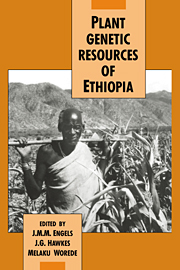Book contents
- Frontmatter
- Contents
- Contributors
- List of acronyms
- Preface
- Part I General introduction
- Part II The Ethiopian centre of diversity
- Part III Germplasm collection and conservation in Ethiopia
- Part IV Evaluation and utilization of Ethiopian genetic resources
- 18 Germplasm evaluation with special reference to the role of taxonomy in genebanks
- 19 Crop germplasm multiplication, characterization, evaluation and utilization at PGRC/E
- 20 Evaluation methods and utilization of germplasm of annual crop species
- 21 Evaluation and utilization of Ethiopian forage species
- 22 Improvement of indigenous durum wheat landraces in Ethiopia
- 23 Use of germplasm resources in breeding wheat for disease resistance
- 24 Indigenous barley germplasm in the Ethiopian breeding programme
- 25 The role of Ethiopian sorghum germplasm resources in the national breeding programme
- 26 Germplasm evaluation and breeding work on teff (Eragrostis tef) in Ethiopia
- 27 Pulse crops of Ethiopia: genetic resources and their utilization
- 28 Oil crop germplasm: a vital resource for the plant breeder
- 29 Significance of Ethiopian coffee genetic resources to coffee improvement
- 30 Use of Ethiopian germplasm in national and international programmes
- Index
20 - Evaluation methods and utilization of germplasm of annual crop species
Published online by Cambridge University Press: 30 October 2009
- Frontmatter
- Contents
- Contributors
- List of acronyms
- Preface
- Part I General introduction
- Part II The Ethiopian centre of diversity
- Part III Germplasm collection and conservation in Ethiopia
- Part IV Evaluation and utilization of Ethiopian genetic resources
- 18 Germplasm evaluation with special reference to the role of taxonomy in genebanks
- 19 Crop germplasm multiplication, characterization, evaluation and utilization at PGRC/E
- 20 Evaluation methods and utilization of germplasm of annual crop species
- 21 Evaluation and utilization of Ethiopian forage species
- 22 Improvement of indigenous durum wheat landraces in Ethiopia
- 23 Use of germplasm resources in breeding wheat for disease resistance
- 24 Indigenous barley germplasm in the Ethiopian breeding programme
- 25 The role of Ethiopian sorghum germplasm resources in the national breeding programme
- 26 Germplasm evaluation and breeding work on teff (Eragrostis tef) in Ethiopia
- 27 Pulse crops of Ethiopia: genetic resources and their utilization
- 28 Oil crop germplasm: a vital resource for the plant breeder
- 29 Significance of Ethiopian coffee genetic resources to coffee improvement
- 30 Use of Ethiopian germplasm in national and international programmes
- Index
Summary
Introduction
Proper evaluation of the very large germplasm collections now assembled for many crop species presents major problems. These arise principally from the effects of the environment on the expression of plant characteristics. For qualitative characteristics there is little difficulty as their expression is usually affected little by environment. Examples are seed coat and flower colour and colour pattern. A single evaluation is all that is required to characterize a set of materials for such characteristics.
It is, however, the quantitative characteristics, and these are of most interest to the breeder, that are especially intransigent as their expressions are always modified by environment to some degree, so that the separation of the contributions of genotype and environment to the phenotype requires special techniques.
Environment and genotype × environment interaction
The modification of plant characteristics by environment takes two forms. First, there is a general reduction or increase in expression of a character across all genotypes. Environmental features such as soil fertility, moisture availability, temperature and pathogens, pests and weeds may all affect plant characters in this way. The result is what is often termed ‘field variability’ and this will always occur in a single evaluation at a single location in a single season. It also occurs across locations and seasons.
Secondly, there is the situation where all genotypes are not affected equally by differences in environment, normally described as ‘genotype × environment (g × e) interaction’.
- Type
- Chapter
- Information
- Plant Genetic Resources of Ethiopia , pp. 268 - 277Publisher: Cambridge University PressPrint publication year: 1991



